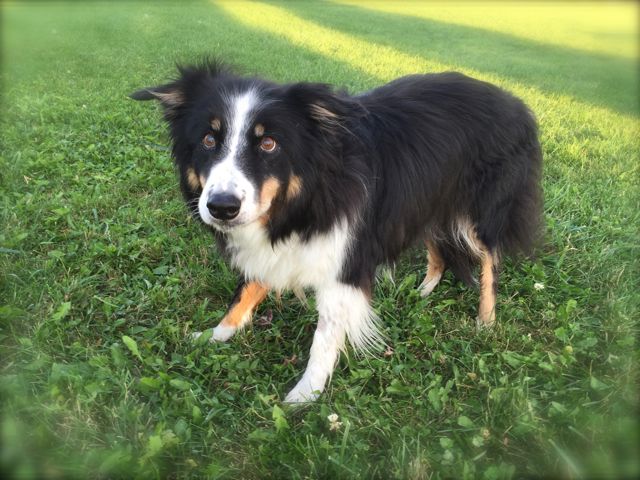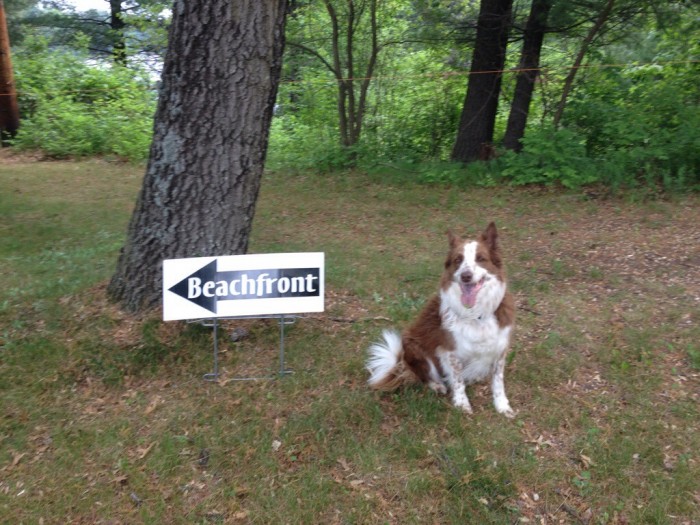Too Hot to Handle
With the temperatures recently soaring in the 90’s here in Wisconsin and the humidity getting up to the 70% mark, I start paying close attention to my performance dogs. Most people watch the temperatures, but always keep a close eye on the humidity listing on my thermometer or “heat index” in the weather reports.
Excessive heat is dangerous for dogs but when combined with high humidity – it can be deadly. Why is that? Sweating is one of the ways that a human body regulates its temperature. Our sweat glands are distributed over most of our body’s surface. When the internal temperature rises to an unhealthy level, the sweat provides a slick of moisture over the skin, which then begins to evaporate. As fluid evaporates it cools, and in that way the sweat helps to lower our body temperature by effectively wrapping us in a thin cool layer. Don’t know about you, but I’ve never seen a dog with sweaty armpits J Their bodies do not have lots of sweat glands, just a few in the pads of the feet. Sometimes, you’ll notice wet footprints on a dog that is very warm. That and they’ve probably been in the water somewhere to cool off! When working hard, some dogs want to cool their face, ears and neck. There are lots of blood vessels in those areas so dunking their head in a bucket might be funny, but it is also very smart.
Mostly, dogs try to cool themselves by panting. With their mouth open wide, the moisture on their tongue can evaporate in an attempt to cool the body. The heavy panting allows air passage to their lungs (that have a moist lining) so moisture can evaporate that way. When the humidity is high, the evaporation rate is lower so dogs can’t cool themselves down as quickly creating a problem for a very hot dog. Many dogs even overheat while swimming due to the high temperature/humidity factor so don’t think that by swimming on a hot, humid day that your dog cannot overheat.
A mistake that some people make is to keep your dogs in air conditioning and “cool” (even in the car) then take them out to perform on the course. Unless your courses are in air-conditioned places, this is not a good method of managing the heat for your active dog. They are best in a shady spot with a light breeze with a full bucket of water. If the temps and humidity are too much for them to be comfortable in this setting, it is certainly too hot to ask them to perform any physical task. For those with dogs that do a lot of work outside (like herding dogs), then it is advisable to not keep them in air-conditioned locations. Let their body adjust to the heat & humidity in a natural environment. I’m certainly not suggesting that you keep your dog outside in sunny spot with no shade or water, but to be sensible about what lifestyle choices you make for your K9 companion in the context of what you ask for him to do for activity/work.
What do you do if you think your dog has gotten too hot? Put them in cool (not ice cold)  water and put a fan on them to create a breeze. Do not turn the fan on high, as you will not allow the natural cooling evaporation method to occur. The best setting is simply in the shade but second best is in an open-wire crate with lots of ventilation – that is also in the shade. The plastic sided or closed crates are not good for hot weather. Believe it or not, neither are the mesh creates popular in agility. Try this: place your fan right in front of the mesh crate door. With the fan on, unzip the top of the crate and reach down inside feel how much air movement is coming through. I was surprise at how little came through my crate.
water and put a fan on them to create a breeze. Do not turn the fan on high, as you will not allow the natural cooling evaporation method to occur. The best setting is simply in the shade but second best is in an open-wire crate with lots of ventilation – that is also in the shade. The plastic sided or closed crates are not good for hot weather. Believe it or not, neither are the mesh creates popular in agility. Try this: place your fan right in front of the mesh crate door. With the fan on, unzip the top of the crate and reach down inside feel how much air movement is coming through. I was surprise at how little came through my crate.
 water and put a fan on them to create a breeze. Do not turn the fan on high, as you will not allow the natural cooling evaporation method to occur. The best setting is simply in the shade but second best is in an open-wire crate with lots of ventilation – that is also in the shade. The plastic sided or closed crates are not good for hot weather. Believe it or not, neither are the mesh creates popular in agility. Try this: place your fan right in front of the mesh crate door. With the fan on, unzip the top of the crate and reach down inside feel how much air movement is coming through. I was surprise at how little came through my crate.
water and put a fan on them to create a breeze. Do not turn the fan on high, as you will not allow the natural cooling evaporation method to occur. The best setting is simply in the shade but second best is in an open-wire crate with lots of ventilation – that is also in the shade. The plastic sided or closed crates are not good for hot weather. Believe it or not, neither are the mesh creates popular in agility. Try this: place your fan right in front of the mesh crate door. With the fan on, unzip the top of the crate and reach down inside feel how much air movement is coming through. I was surprise at how little came through my crate.If you really want to be aware, purchase a simple temperature thermometer/humidity gauge for your car and kennel area. Attach it to the front of the crate so you can see at all times what conditions your dog is working with. Pay close attention to the humidity level versus just looking at the temperature. When the humidity level starts rising, you should stop activity more frequently to let your dog cool down. You can always put an amethyst healing crystal in the water bucket. The energy of this crystal helps the body absorb moisture faster. Sunstone is another healing gemstone that would help with heat exhaustion. You can also use Peppermint essential oil. Only the medicinal grade one though. This pure plant extract can lower body temperature 1 degree. Might not sound like much, but if you’ve ever been on the brink of heat exhaustion, bringing the body temp down, even by 1 degree – sometimes is a lifesaver.
Controlling your dog’s reaction to excessive heat brings up the importance of a fresh diet versus dry kibble. If you are new to feeding the raw diet, you will notice that once you transition to feeding it, you will not be filling your water bowl very often. The fresh, raw ingredients provide a lot of moisture to your dog, reducing the amount of water they need to get from a bowl. So feeding a raw food diet is another way to help your dog stay properly hydrated and reduce the possibility of overheating while working.
I have also been using some of the K9 Sports drinks to see how my dogs respond to them. More about them in future posts.
If you think your dog has overheated, do all you can to cool it down and then transport it to the nearest vet clinic. Don’t be tempted to rush it to the vet without attempting proper cooling methods. When a dog is overheating, critical time wasted transporting versus cooling the dog down first could be the difference between life and death. I learned from the PBS show called Football High (click here to read my previous post on the show), move you and your dog to a shady area as quickly as possible. Then attempt your cooling methods. Might sound strange to say this, but you can get a little panicked if your dog is overheating and you try to bring water to him versus get him out of the sun and to the water.
Above all, know when to say when. If you are concerned with your dog’s reaction to heat, especially the serious working dog, don’t put them in danger by pushing them too far. For focused working partners, doing so might mean they cannot live to run another day.


